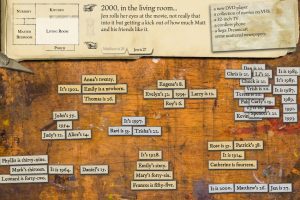18 Cadence and the Infinity of Storytelling
When I first signed up for ENGL342, I was most looking forward to the games module – a familiar medium. I quickly pushed the other, scary looking topics out of my mind (what on earth is web based or interactive fiction!?), so they would not deter me from taking the paper. With this in mind, I am surprised that now at the end of the course, the text which has stuck with me the most is 18 Cadence by Aaron Reed.
18 Cadence is a piece of web-based fiction which tells the story of a house over the timeline of a hundred years. When you start the narrative, you can choose to read the story from beginning to end, or from the end to the beginning – this in itself was enough to make me anxious, I prefer to have my options limited and to more or less be told how to read something. Choosing “begin at the beginning”, I was met with more horror at the interface which resembled a bare crafting table. Panic rose in my chest as I realised I could follow the story by room, character, object, or year – and I could arrange the text on my craft table in any order to create endless narratives. Everything in the narrative had its own story to tell. I ended up following the room of the nursery, dragging text to create a picture of its contents, and becoming emotional over the changes which took place as the years went by. My earlier prejudices about the rightful place of stories being on paper or disc, soon disappeared as I found myself completely immersed in the fates of each of the children who passed through the same walls.
The text opened up a whole new way of storytelling for me, both fictional and real. Before encountering the text I searched for narratives in books, sometimes games – but after playing around with the story a few times, I began to look for stories around me. More specifically, the story of my flat.
Google tells me that the mansion my flat is engulfed in was first built in the 1930s. After returning from the tutorial where we read 18 Cadence, I longed to know more than this simple date. I wanted the story of when its original, wealthy owners, were forced to leave. When new walls were added to split it into four flats over three stories, and what the function of all of the rooms use to be. What lies within the ancient wooden cupboard which for some reason, has been kept in my bedroom, with no key to fit the lock. When and why someone decided to leave their iron on the floor on the hallway, which has left a deep burn in the carpet. And how my short time in part of this house, would mark its history and extend its narrative another year: from the hole my fiance accidently knocked into the wall when moving his desk, even the chipped piece of paint in the lounge from when my kitten tried to climb the wall.
Digital literature has opened my mind to the wonders of storytelling, in its various forms, and has lit a passion within me to find the narrative of the smallest, most abstract, mundane, or inanimate, things.



